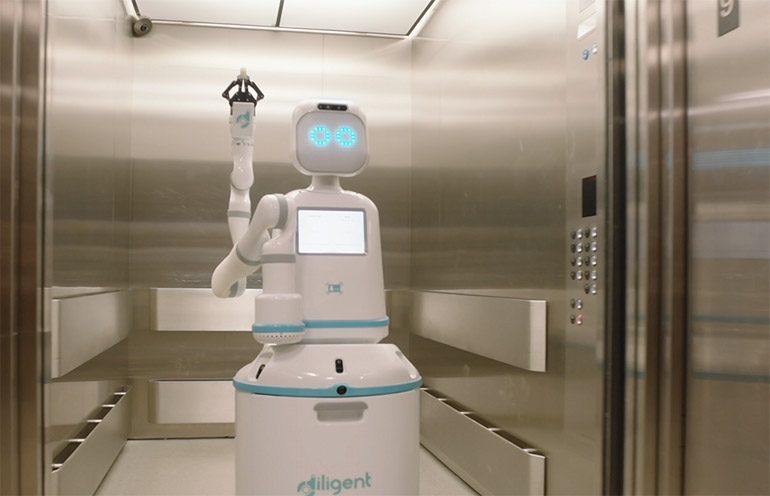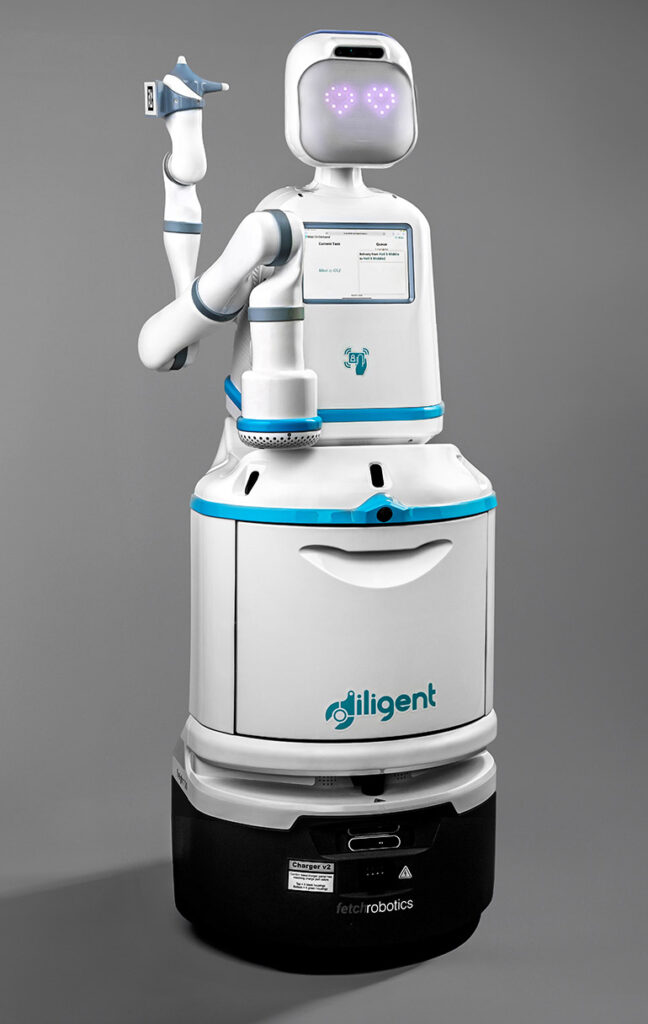|
Listen to this article  |

“Humanoid for hospitals” Moxi has an arm to open doors and operate elevators. Source: Diligent Robotics
As the development of humanoid robots continues, one mobile robot is already working in hospitals. Diligent Robotics Inc. announced today that its Moxi robot has completed 110,000 autonomous elevator rides in healthcare systems across the US.
The mobile manipulator has one arm for opening doors and pressing buttons for operating elevators. Moxi’s success represents a milestone in AI-driven automation for unstructured healthcare environments, the Austin, Texas-based company said.
“Achieving autonomy in robotics, especially in the healthcare environment, is an incredible challenge,” said Andrea Thomaz, CEO of Diligent Robotics and a 20-year AI veteran. “Elevator navigation seems simple, but the unpredictable nature of shared spaces, real-time changes, and the need for precision make it one of the many difficult tasks that humanoids deployed in human environments need to solve.”
“With Moxi, we have demonstrated the ability to integrate AI into environments where human-robot collaboration is vital to success,” she added. “To date, we complete more than 20,000 fully autonomous elevator rides every month, which none of our competitors do.”
 Sign in to speak.
Sign in to speak.
Moxi is moving towards greater autonomy
Founded in 2017, Diligent Robotics said it has incorporated Moxi into existing healthcare workflows, such as supply delivery and round-the-clock transport of lab samples. The company said its robot helped improve operational efficiency and allowed busy employees to focus on patient care rather than routine transportation tasks.

Diligent CEO Andrea Thomaz with Moxi. Source: Diligent Robotics
Diligent Robotics used “humans in the loop” to develop Moxi’s autonomy and ability to interact with elevators.
“There are two approaches: Waymo, which used its own drivers and did research and development until its product was fully autonomous, and Tesla, which got its product out into the wild with real customers and increased autonomy with supervision over time,” Thomaz said. Report on robots. “We took the second approach.
“This milestone means we no longer need the strict human supervision that is important for mobile handling,” she said. “The number of rides per day really shows that we’ve gotten past R&D and into production.”
When it first deployed its robots, diligent employees oversaw operations on site. They obtained labeled data for AI models, Thomaz explained. The company can now remotely supervise its fleet of 100 robots in 20 locations.
“Many of our early partner hospitals have gotten used to having our staff around and doing whatever the robots need,” Thomaz said. “It’s actually been easier for hospitals in recent months because they’ve had fully autonomous robots from the start. For sites that were previously under human supervision, we went through a data collection phase and asked staff to do nothing.”
Moxi opens the door, a model for further actions
How hard was it to get Moxi to control the elevators?
“They have become a road map for autonomy,” Thomaz replied. “Almost every birth passageway involves a lift requirement, from the basement pharmacy or laboratory to the patient ward. In the simplest elevator, you press a button and get on.”
“The most complicated thing that works today, you have to scan the badge to activate the buttons and then press them,” she said. Report on robots. “There are a lot of patient floors that are secure. It’s a tricky manipulative skill for a dual device, mainly because of the swipe speed.”
By solving the problems of handling various doors and elevators, Diligent Robotics develops complex action models.
“Our ability to develop models that are specific to these small skills creates an infrastructure of training models that could then be applied to other skills,” Thomaz said. “They’re not big general purpose models, but we’re excited to have a fleet that we can use to build basic models.”
Complex environments still present challenges

Moxi can interact with people around him through his screen, shown here in idle mode. Source: Diligent Robotics
As an environment with trained but busy staff, a high degree of safety regulations, and the general public—some of whom are not well off—hospitals are particularly challenging for robots.
“That’s why we handled it with white gloves; we don’t just let robots learn by themselves,” Thomaz noted. “We spent two years deploying robots with humans because of the sensitive environment and making the robots work efficiently.”
For example, she cited interventions where medical staff press an emergency stop button and can manually move the robot out of the way for something like an emergency cart. Sometimes they forget to turn the robot back on to continue its mission.
“We released a feature where the bot can ask on the screen for someone to stop it,” Thomaz said. “There are other environments, like the elevator bay with six different cars and patients coming in and out, that are still complex.”
“Moxi also uses data to avoid routes or elevators that are always busy,” she said. “We collect this data and prioritize elevator shafts at night versus day.
Diligent Robotics is working to standardize robots
With an aging population and workforce challenges, demand for automation is likely to grow, Diligent Robotics said. Moxi provides an example of how robots can solve human needs.
“I referred to Moxi as a ‘humanoid for healthcare’. We’re doing things that people are talking about what humanoids could do,” Thomaz said. “Bipedal locomotion isn’t the hardest part – it’s the usability of the mobile manipulation. Most humanoids are still proof of concept.’
“When I walk through the hospitals where Moxi is deployed, it’s the first robot that many people have encountered,” she added. “Patients are getting used to seeing a future with robots.”
“Achieving full autonomy to enable transport throughout the hospital is just scratching the surface of what humanoid robots like Moxi will do inside and outside of hospitals,” said Thomaz. “The knowledge and trust we gain from the healthcare environment will drive future product development. We look forward to building humanoid social robots that will collaborate and help care for people in many different environments.”

